Pricing Guides & Dictionary of Makers Marks for Antiques & Collectibles

Appraisal Values & Pricing Factors for
BLUE WILLOW COLLECTIBLES
Join the most updated and complete collectibles research online - Learn more...
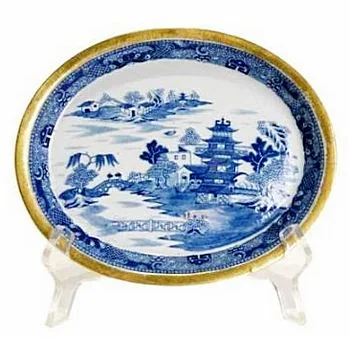 The Blue Willow Pattern, depicting the popular old Chinese story & poem - see more details on the Willow legend - falls in the same category as Blue & White Chinoiserie wares, yet it is a distinctly British design that was adopted by many UK earthenware companies and Staffordshire potteries. It began around late-18thC and mass production techniques such as transferware (decals) which was already developed at that time, helped in quickly propelling it to a very trendy and fashionable decorative style.
The Blue Willow Pattern, depicting the popular old Chinese story & poem - see more details on the Willow legend - falls in the same category as Blue & White Chinoiserie wares, yet it is a distinctly British design that was adopted by many UK earthenware companies and Staffordshire potteries. It began around late-18thC and mass production techniques such as transferware (decals) which was already developed at that time, helped in quickly propelling it to a very trendy and fashionable decorative style.
The somewhat romantic nature of this pattern with exotic Oriental overtones, was produced in many variations, yet all were very characteristically similar, with the only differences being tiny details on the overall landscape or background. Chinese design influences were still prominent in Europe at that time and many companies felt that the Blue Willow pattern offered a great opportunity of promoting locally produced tableware, while riding on the fame and desire for celebrated Porcelain imports from the Far East.
With the rise and expansion of so many companies producing chinaware, coupled with rapid industrialization methods during the 19thC, the manufacturing of earthenware in the Blue Willow pattern in all sorts of forms & shapes, proliferated quickly and created an overwhelming abundance of such wares, many available at cheap prices and easily affordable by most families. For these reasons, Blue Willow tableware has survived in vast numbers in the antique market, yet continues to be an attractive collectible.
Polychrome Blue Willow versions seem to have appeared around Victorian times. These are fine renditions and are usually preferred by many collectors interested in having such pieces displayed. There are fewer of those in number, so they appraise at higher prices. In this case, colored Blue Willow plates are also acceptable, even if only a partial set, because of their aesthetic impact. Both the traditional Blue & White and enhanced versions are now being copied furiously by factories in China and elsewhere in the Far East. Makers' marks are also forged and can easily mislead even an experienced dealer. Caution and research are required to correctly identify the maker and origin or age of each piece. Using our Ceramics marks guides can steer you in the right direction or use our Inquiry Form to ask our specialists directly.
Appraisal values for Blue Willow depend primarily on three factors: Condition, Rarity of Shape, and Completeness of Set. Condition is quite self-explanatory, especially as one considers the utilitarian nature of most related wares. The rarity of shape refers to its function and size, for example, serving pieces such as Tureens, Large Platters & Bowls, Jugs, etc seem to fetch much higher prices than Dishes or Plates and Cups & Saucers. Some of the rarer forms are often afforded some allowance in maintaining a higher value for very slight defects or professional restoration because they are fewer of those available and are at times destined to be used primarily as display pieces. When it comes to ordinary or everyday items in the Blue Willow pattern, the completeness of a Set is paramount. In most cases, six of each is sufficient to call it a set, but four is acceptable also, especially if made by a reputable or famous company. More than six in a set is definitely a bonus.
Unlock the true value of your collection with our comprehensive research guides from identifying makers' marks to appraising all kinds of antiques and collectibles, including items featured in this article.
Our up-to-date information will give you an accurate understanding of your items' worth. Don't miss out on this valuable resource - visit our research tools today!
In addition to some examples shown below on this page, you can also search our price guide for your own treasures.
Examples of related items from our Price Guides
-
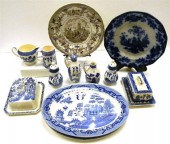 Staffordshire eleven items of transfer-
[more like this]
Staffordshire eleven items of transfer-
[more like this]
-
 (9) Pcs transferware porcelain, c/o Maso
[more like this]
(9) Pcs transferware porcelain, c/o Maso
[more like this]
-
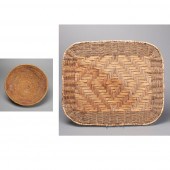 HOPI/JICARILLA APACHE, PAIR OF BASKETS:
[more like this]
HOPI/JICARILLA APACHE, PAIR OF BASKETS:
[more like this]
-
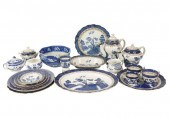 BOOTHS REAL OLD WILLOW BLUE CHINA PARTIA
[more like this]
BOOTHS REAL OLD WILLOW BLUE CHINA PARTIA
[more like this]
-
 W. Adams & Co flow blue transfer-decorat
[more like this]
W. Adams & Co flow blue transfer-decorat
[more like this]
-
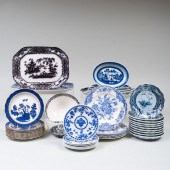 GROUP OF BLUE AND WHITE PORCELAIN TABLEW
[more like this]
GROUP OF BLUE AND WHITE PORCELAIN TABLEW
[more like this]
-
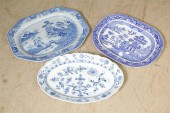 THREE BLUE AND WHITE PLATTERS. Including
[more like this]
THREE BLUE AND WHITE PLATTERS. Including
[more like this]
-
 Two Staffordshire blue transferware chin
[more like this]
Two Staffordshire blue transferware chin
[more like this]
-
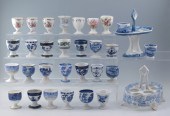 33 PIECE COLLECTION EGG CUPS AND TWO STA
[more like this]
33 PIECE COLLECTION EGG CUPS AND TWO STA
[more like this]
-
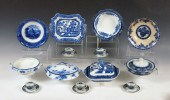 ESTATE GROUP OF ENGLISH FLOW BLUE BLUE W
[more like this]
ESTATE GROUP OF ENGLISH FLOW BLUE BLUE W
[more like this]
-
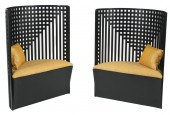 2 CHARLES RENNIE MACINTOSH STYLE 'WILLOW
[more like this]
2 CHARLES RENNIE MACINTOSH STYLE 'WILLOW
[more like this]
-
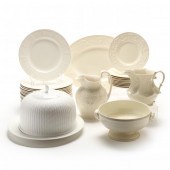 A GROUPING OF (31) WEDGWOOD PORCELAIN DI
[more like this]
A GROUPING OF (31) WEDGWOOD PORCELAIN DI
[more like this]
There are many more auction results available to our members...





